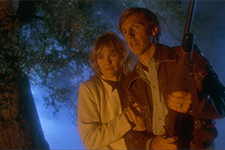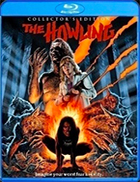The Howling
|  For whatever reason, 1981 was the year of the werewolf. After there not having been a major werewolf film since Hammer’s The Curse of the Werewolf back in 1961, the second year of the ’80s saw the release of not two, not three, but four major Hollywood-produced werewolf films, which included (in order from serious to not-so-serious) Michael Wadleigh’s Wolfen, John Landis’s An American Werewolf in London, and Larry Cohen’s Full Moon High. The first one out of the gate, though, was The Howling, which helped to solidify director Joe Dante’s stature as a filmmaker with a real gift for mixing horror and dark comedy. It also established Rob Bottin, a protégé of Rick Baker’s, as one of the most gifted practical effects artists of his generation. His utterly convincing werewolf transformations, which were achieved completely with practical applications such as air bladders and prosthetics, set the stage for the surreal effects he created for John Carpenter’s The Thing (1982) and other films such as Legend (1985), which netted him an Oscar nomination, RoboCop (1987), Total Recall (1990), and Se7en (1995). Loosely based on the 1978 novel by Gary Brandner, The Howling takes place primarily at a self-help retreat in northern California, where a television news journalist named Karen White (Dee Wallace) goes with her husband, Bill (Christopher Stone), after she is nearly murdered by a serial killer that had been stalking her. The film’s opening sequence finds Karen acting as willing bait for the police as she calls the stalker and then agrees to meet him in a porn shop. These opening moments are both suspenseful and incredibly grimy, as if Dante decided to channel the seedy vibe of Paul Schrader’s Hard Core (1979) or William Friedkin’s Cruising (1980). Things get lighter once Karen, who suffers from post-traumatic stress following her near-murder, and Bill arrive at the ocean-side retreat, which is run by Dr. George Waggner (Patrick Macnee) and is home to a group of colorful eccentrics, including John Carradine’s grizzled old Erle Kenton and Elisabeth Brooks’s vampish nymphomaniac Marsha. It doesn’t take much to guess that this supposed place of respite is actually a haven for werewolves, and the only real question is how many of the people there spout hair, fangs, and claws (unlike traditional werewolf lore, these can wolf out at will, which makes them that much more threatening). The Howling was made by a group of recent graduates from Roger Corman’s New World Pictures, where they had learned how to make the most of every bit of their low budgets and (perhaps more importantly) not to take themselves too seriously. The Howling is laced with humor, some of it offbeat and eccentric, some of it dark, and some of it just silly (try to count the number of visual “wolf” jokes, from prominently placed cans of Wolf brand chili, to a copy of Allen Ginsburg’s “Howl” on a table). Joe Dante had previously directed the self-aware Jaws knock-off Piranha (1978) for Corman, and producer Michael Finnell, who went on to produce virtually all of Dante’s films in the 1980s and ’90s, had worked his way up the Corman ranks, starting as a production assistant and production manager before producing Rock’n’Roll High School (1979), on which Dante did uncredited directing. The film was written by John Sayles, who took a page from the Orson Welles and John Cassavetes playbook by funding his own independent productions like The Brother From Another Planet (1984) and Matewan (1987) with his paychecks for writing genre fare for Corman like The Lady in Red (1979), Battle Beyond the Stars (1980), and Alligator (1980), and first-time scribe Terence H. Winkless, who became a prolific director of B-movies like The Nest (1987) and Not of This Earth (1995) and television series like Mighty Mophin Power Rangers and Pacific Blue. Of course, humorous and self-aware as it often is, The Howling fundamentally works as a scary-gory werewolf thriller, with Bottin’s transformation effects casting a nearly hypnotic spell as we watch in grisly detail as faces elongate into snouts, fangs emerge, ears grow long, and hair sprouts all over, all of which is filmed in close-up detail that remains utterly and completely convincing even decades later. At the same time, the film also functions as a sly satire of everything from the shallow nature of television news (the newsroom is run by a sensation-seeking producer played by Kevin McCarthy, star of the original Invasion of the Body Snatchers), to the absurdity of the New Age-y self-help fads that dominated the 1970s (which also happened to be the subject of Phillip Kaufman’s 1978 remake of Invasion of the Body Snatchers). Like many horror films of its era, the underlying dread of The Howling is that horror is everywhere, even in bucolic ocean-side retreats and television newsrooms. The film ends, of course, with a joke, and a delightfully cynical one at that: We have become so accustomed to both real-life horror and its make-up effects variety on the big screen, that even when faced with the worst, we may very well just blow it off.
Copyright © 2021 James Kendrick Thoughts? E-mail James Kendrick All images copyright © Shout! Factory | |||||||||||||||||||||||||||||
Overall Rating: 

 (3)
(3)


